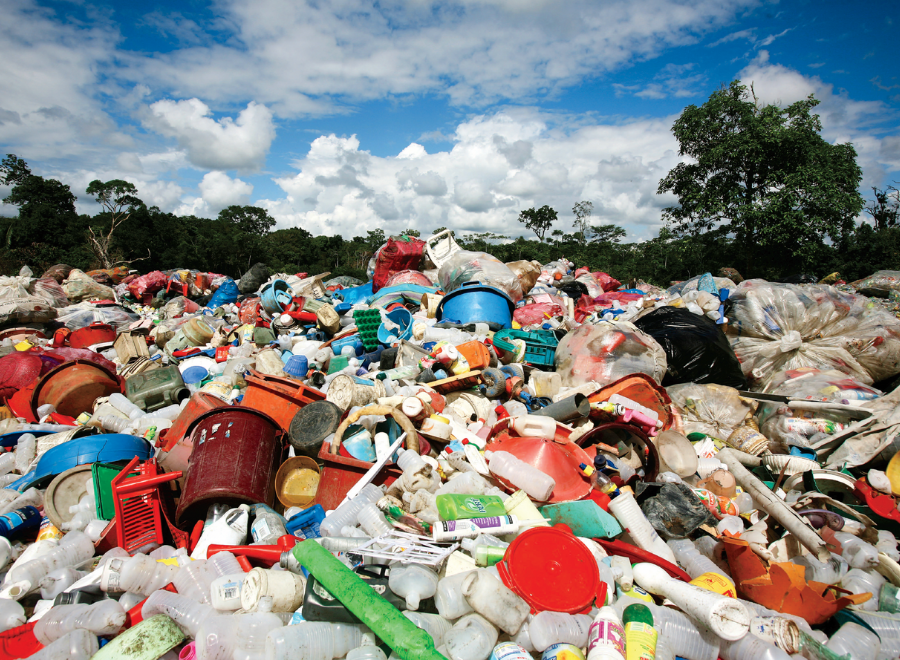It’s July in Toronto, and the garbage is piling up. Heaps and heaps of trash are strewn across the city: mountains of black plastic bags fill up designated parks; stuffed shopping bags left on the sidewalks attract rats and other vermin; and taped-off city garbage cans are ripped open to spew Starbucks cups and Big Mac wrappers. Thank goodness it’s not hotter, some say, because the smell would be horrendous. Thesmell isn’t lilacs and lavender as it is.
For more than a month, the Toronto garbage strike makes national news, and Canadians all over watch as the city’s waste accumulates. But along with the growing mounds of garbage, tentative discussions about conservation begin as people consider the trash — the packaging, the unused stuff, the for- gotten purchases — they throw away daily without thinking.
You may unsubscribe from any of our newsletters at any time.
There’s nothing like a garbage strike to make us contemplate the waste we produce. And it’s more than just the trash that was strewn around Toronto; statistics compiled by Annie Leonard, the founder of the U.S.-based www.storyofstuff.com and author of the upcoming book The Story of Stuff, show that for every can of garbage lugged out to the curb by an individual in the United States, another 70 cans are thrown away by the industries that create the products.
But even the products we buy and keep create garbage. For example, the No Dirty Mining Gold campaign states that about 20 tons of mine waste is created to produce one gold ring. In fact, taking into account all of the materials used in mining, processing, harvesting, packaging and transportation, and all of the materials that make up the products we buy, 99 percent are thrown away within six months. With each bag of garbage comes a new hazard to the environment: about 20 percent of Canada’s share of global warming gases comes from landfill sites, and that’s not even considering those released from creating and transporting the goods we throw away.
Yet, popular wisdom has it that we’re getting greener. Ads for green products filter past us on the television, eco-resorts around the world flourish, tips for greener living fill the pages of magazines. Recent surveys show that Canadians are trying to live greener: according to a Statistics Canada report released at the beginning of this year — based on polling conducted in 2007 — 84 percent of households have at least one energy-efficient light; 42 percent have a programmable thermostat; 62 percent have a low-flow shower head; and 39 percent have low-volume toilets.
But in that same year, 2007, Canada produced 19.05 tonnes of carbon dioxide per capita. And in a recent ranking of G8 countries’ climate performance compiled by the World Wildlife Fund, Canada came in dead last, moving down one ranking from the year before to replace the United States in eighth place.
All of that garbage and all of those numbers invite the question: in a world that’s suddenly become populated with self-proclaimed environmentalists, are any of us truly doing enough?
“Certainly more people than ever are doing something,” says Alex Steffen, editor of Worldchanging: A User’s Guide for the 21st Century. “But there’s also some evidence that a lot of people are doing one or two or three small things and thinking that they’ve got it licked.”
And that, as it turns out, might be almost as bad as doing nothing at all. By making small changes like buying better light bulbs or low-flow shower heads, individuals are reducing their impact by maybe three to five percent, Steffen says. Armed with the illusion that we’re doing our part, we stop there. In fact, many of us are fooling ourselves into thinking we’re doing more than we actually are; a July study by Quebec-based research and communications firm Cossette and Summerhill showed that gaps of up to 40 percent exist between what Canadians think they’rdoing for the environment and what they actually do.
So, what’s the problem? Why, if people know enough to recognize the need for programmable thermostats, can’t we make a deeper change?
Partly responsible is the society we live in: our consumer culture places emphasis on what we own and how much stuff we have. On average, Americans consume twice as much as they did 50 years ago. “We’re massively over-consuming. Massively, massively over-consuming,” says Greg Mikkelson, a McGill University associate professor, jointly appointed to the School of Environment and Department of Philosophy. “In the U.S., something like one-and-a-half times as much money each year is spent on advertising as on education, all the way from kindergarten to PhD….[The ads] convince us that we’re inadequate as we are, and in order to be adequate, in order to feel better, we have to go out and buy something.”
The garbage that piled up around Toronto this summer, then, wasn’t without its root cause. But somewhere along the way, environmentalism itself partnered up with consumerism (or, as Mikkelson puts it, was “co-opted” by consumerism), giving us green cosmetics, organic sheets and a greener, friendlier Wal-Mart. According to Canadian-based environmental marketing agency TerraChoice, the average number of so-called green products per store almost doubled from 2007 to 2008. (Examining 2,219 green products throughout North America between November 2008 and January 2009, TerraChoice also found that 98 percent of them weren’t as green as they let on; rather, green claims came with hidden tradeoffs, lacked proof, were irrelevant, or — in the case of something like organic cigarettes — were simply distracting from the harm created by the overall product type.)
The costs and benefits of green consumerism have been debated among environmental organizations. On one hand, Lindsay Coulter, the David Suzuki Foundation’s “Queen of Green,” says that buying green products can be a stepping-stone for consumers looking to introduce further changes into their lives. “It might start off with them buying their own bamboo cutting board . . . and then realizing there are things that they can do without or have less of,” she says. “It’s a gateway, I think, to start.”
Steffen, though, doesn’t believe that’s actually what happens. Instead, he feels that green consumerism runs the risk of giving consumers a false sense of accomplishment, reducing the chance of further change. “It deludes us into thinking we’re going to shop our way into sustainability,” he says. “I think the biggest problem with green consumerism is the illusion of having accomplished something.”
The good news, adds Elizabeth May, leader of the Green Party of Canada and author of How to Save the World in Your Spare Time, is that consumerism isn’t inherent to our psychological makeup. We can shake it, she says. “It’s certainly not an innate human virtue to think, ‘Shop until you drop,’ but we’ve recreated our sense of values, and we’ve habituated ourselves into a wasteful culture,” she says in an interview. “I think we’re in the process of cracking that.”
The bad news — if you listen to some researchers — is that even though consumerism may not be intrinsic to our makeup, there could actually be something else that keeps us from reacting urgently to an issue like global warming. From an evolutionary perspective, some social scientists argue we’re conditioned to respond to immediate, human-scaled risks that trigger emotional rather than intellectual responses; the risks perceived, for example, when someone senses a stranger in a dark alley or hears about the terrorist attacks of 9/11. Climate change, though, is slow moving, large-scale and hard to put a face on — a risk that causes intellectual concern but not an emotional response, at least not until things get a lot worse.
“Global warming doesn’t make evolutionary sense to us,” Columbia University professor and psychologist Elke Weber, chair of the Global Roundtable on Climate Change’s public attitudes/ethical issues working group, told Greater Good Magazine last fall. “Our minds haven’t adjusted to the much more complex technological risks that are removed in space and time.”
If our individual inaction is based on centuries of evolution, then what’s the solution? Because even though climate change may not be happening quickly enough for us to react urgently, it is happening faster than science anticipated. Previous predictions underestimated the effects of global warming, says Aaron Huertas, spokesperson for the Union of Concerned Scientists. “Most scientists point to around two degrees Celsius above pre-industrial levels as the point where you start to get some of the worst effects of climate change and where some of those changes become irreversible,” he adds.
Currently, we’re 0.7 degrees Celsius above pre-industrial levels. “For a lot of things, we’re either in the threshold or approaching the threshold,” Huertas continues. “The sooner we act, the less likely it is that we’ll cross those thresholds.” Which means that maybe we don’t have time to wait for evolution to catch up before we make real changes.
What’s the alternative? In the mainstream media and for some environmental agencies, it’s the tip-list approach to green activism. What might have started with “reduce, reuse, recyle” has now blossomed to include green tips for all occasions: “Ten tips for avoiding plastic,” “Top 10 green travel tips,” “Eight ways to a green wedding,” and so on.
The point of green tips, says Coulter, is to give bite-sized solutions to people who want to make eco-friendly choices.
“People seem to have a finite pool of worry; there are only so many things you can take at a time,” she says. “[They] want simple steps, straightforward solutions — tell me what to do, tell me what the better options are — and they’ll start to take action.”
But, Steffen suggests, the danger of that approach is that it not only underestimates people’s ability to handle the whole truth, but it also gives them licence to focus on tiny steps at the cost of the bigger issue. In the process, maybe it also keeps us from feeling those strong emotions that psychologists say are precipices to real change.
“You see Al Gore’s movie [An Inconvenient Truth], with a giant civilization-ending problem, and the solutions at the very end are little things you can do at home,” Steffen says. “I think that is problematic because it ignores the whole idea that democracy is based on, which is that regular people can understand complex problems and come to a decision together to meet those challenges. And certainly we’ve seen situations in the past where people have done those things — whether it’s about individual liberties or group rights or suffrage for women.”
It’s not that the tips aren’t a step in the right direction, Steffen adds; if millions of people change all of their light bulbs or refuse plastic water bottles, there will be an effect. It’s just that, given the urgency of the situation, change might not be happening quickly enough, he says.
Are people ready to take bigger steps? After all, the idea of big change is usually equated with big sacrifice: getting rid of a personal automobile, cutting down on air travel or giving up meat, for instance. Take the federal election of 2008 as an example: just a year after Statistics Canada captured data showing that 84 percent of Canadian households plugged in energy-efficient light bulbs, those same Canadians were asked to decide whether they were willing to sacrifice some of their tax dollars to the Liberal party’s proposed carbon tax.
Canadians opted against it, instead voting in a government that has refused to agree to G8 targets for emission cuts, calling them nothing more than “aspirational.”
Of course, there were other reasons for the Liberals’ loss at the polls, but the carbon tax was a front-and-centre campaign promise, one that Canadians couldn’t get behind. “We did a lot of research after the election, because the environment was at such a peak, and the topic was on everybody’s radar,” says Coulter. “It’s really hard to piece that all together — whether it was the messaging, the attacks or that people just voted by party.”
Green leader May holds out hope that the carbon tax failed on a federal level not because people weren’t interested in change — or unwilling to accept some sacrifice to achieve it — but simply because it wasn’t explained properly or didn’t get enough attention. “I don’t think we can say voters chose something other than a good climate plan, because it’s never really been the central issue in a campaign,” she says.
And while May, of course— as the leader of a federal party committed to green issues — will tell us that’s exactly what we need, it turns out she’s not the only one who thinks so. Because real change, the kind of change that’s needed, Steffen says, is going to take government participation.
It’s going to take individual action, too, but not the kind that comes in a shopping cart. What Steffen advocates is good old-fashioned activism. “The problem is not that we are not each doing enough in our lives, but that we’re not doing the right things,” he says. “The more people who can move up that ladder of engagement, the better our odds get.” It might be as easy as starting a green committee at church or at work.
For church people, finding the motivation to change might mean drawing on faith. At least that’s what United Church Moderator Mardi Tindal sees happening. “The faith that I see in United Church people is oftentimes a faith that’s very engaged,” she says.
Though Christians are often criticized for being too focused on the afterlife at the expense of the here and now, Bob Vernon, a leading member of a UK-based interfaith group focused on the environment, sees taking care of the Earth and God’s creation as part of his religious commitment. “We keep talking about the kingdom of heaven, which is the same as the kingdom of God, as if it were somewhere and somewhen else,” says Vernon. “Jesus didn’t do that. From the start he announced that the kingdom of God is here, in the midst. All we have to do is start doing things God’s way.”
What everyone can agree on is that solving the current problems isn’t necessarily about introducing more green products. Rather, the answer may be to think differently, look at things through a green lens, simplify life and consume less.
“To me, the most important thing is that we’re honest with ourselves about how far we have to go,” says Steffen. “I’m certainly not offended when somebody says, ‘I’m doing this about the environment’ and it’s not the thing that I would want them to do. It’s when people say, ‘I’m doing this for the environment, and that’s all I need to do.’ That almost invariably is wrong. Effectively, none of us are doing enough.”
***
This story first appeared in The United Church Observer’s November 2009 issue with the title “When green isn’t green enough.”













